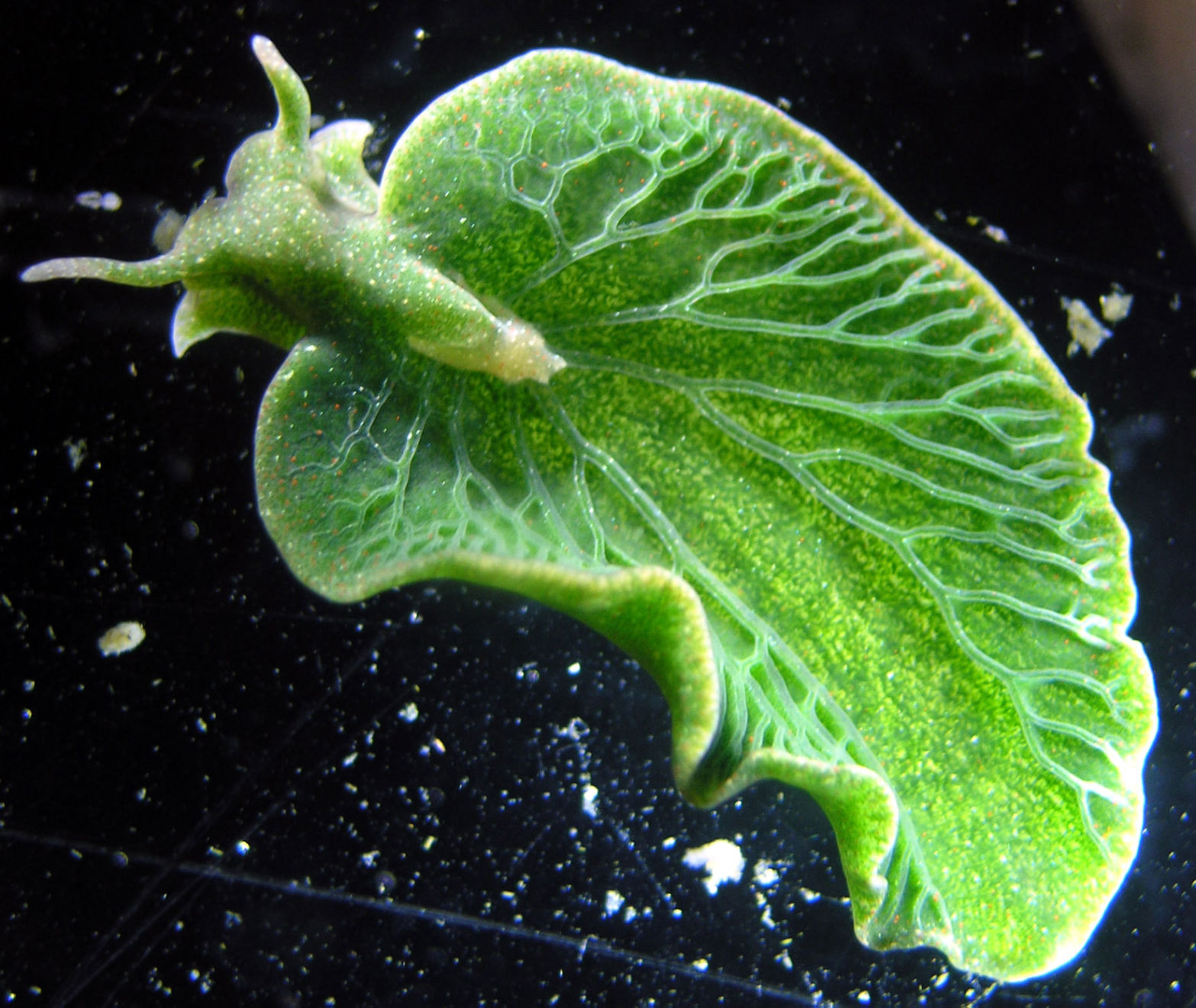
Sea Slug
The adage “you are what you eat” takes on new meaning for one type of sea slug that absorbs cells and DNA from the algae it consumes in order to live life like a plant.
A type of green sea slug — the eastern emerald elysia — looks like a leaf and acts like one too. It’s able to photosynthesize because it absorbs chloroplasts from the Vaucheria litorea algae it eats.
Scientists have known about the peculiar plantlike abilities of these slugs for decades, said Sidney Pierce, an emeritus professor of biology at this university. But a paper published in The Biological Bulletin on Feb. 3, however, suggests these slugs actually take genetic material from the algae and integrate it into their own chromosomes to make it possible.
“We’ve been able to demonstrate the presence of a gene from another species that’s been transferred into a host cell,” said Pierce, a co-author of the study. This kind of hybridization is common between single-celled organisms, but in multi-cellular organisms it is much rarer, especially among animals.
The slugs researchers studied live off Cape Cod and get their chloroplasts — plant cells made up of chlorophyll, a light-absorbing pigment — from their first algal meals.
While this kind of cell integration may seem unexpected on its own, it’s even harder to explain considering the fact that these chloroplasts should break down over time, but the slugs seem to be able to keep them all their lives, Pierce said.
“During a normal process of photosynthesis, there’s constant damage occurring to the photosynthetic apparatus,” said Charles Delwiche, a professor in the cell biology and molecular genetics department at this university, who was not involved in this study. “So to keep the chloroplasts functional, that photosynthetic apparatus has to be continually replaced.”
This study suggests that this is possible because the slugs have integrated into their own genome algal DNA that codes for synthesis of proteins and maintenance of the chloroplasts, Pierce said.
The researchers used a DNA imaging technique where they reacted the slug chromosome to a piece of algal DNA. Because the algal DNA stuck to a specific part of the chromosome, that means a complementary piece of DNA is in the slug, Pierce said, which is “almost unequivocal evidence” that the sea slug has plant DNA in its genome.
This kind of hybridization comes in handy for the sea slug.
“The amazing thing is not only are [the genes] taken up, but if you shine light on the animal it photosynthesizes just like a plant,” Pierce said. “It doesn’t need to eat after it has the chloroplasts.”
Instead it can survive for long stretches of time without any meals, which Pierce called “a hedge against ecological disaster” and food shortages. Chloroplasts can stay in some slugs for as long as 10 months, which is their whole life cycle.
It’s still not known entirely how the slugs take in the chloroplasts and genes from the algae, but Pierce said it could be an accidental byproduct of the way they eat.
When people eat a hamburger, they take in a mouthful of cow DNA, Pierce said, but all of that gets broken down in chemical digestion.
Mollusks — including squid, clams and slugs — don’t have chemical digestion and only digest food mechanically, breaking it down in their mouths and then taking it directly into their cells. This could allow some cells and genetic information from the food to stay with the mollusk.
“For whatever reason, slugs have gotten to be very good at using parts of other organisms,” Pierce said.
Other kinds of sea slugs eat coral polyps and incorporate their stinging cells into their own defense system, and another takes on the defensive chemicals that it gets from sponges.
“We tend to think of these categories of plants and animals as so different,” said Antony Jose, a cell biology and molecular genetics professor at this university who was not involved in this study, adding that it’s incredible to see these different systems come together in these slugs.
Delwiche said that a previous analysis of a partial genome of this sea slug had failed to find genetic material matching the algae, contradicting this recent study. These two findings would have to be reconciled, he said, noting it was possible that the partial genome simply didn’t include the plant DNA or that there could be another explanation.
“Where there’s uncertainty is exactly what mechanisms the sea slug is using to maintain those chloroplasts,” Delwiche said. “It’s very interesting if it’s using genes from the algae, but it’s a really, really interesting case either way.”
Pierce said this kind of horizontal genetic transference eventually could be useful to the field of genetic therapy, a growing concern in medical research as so many human conditions, from diabetes to cancer, are a result of genes breaking down or not working correctly.
It may be some time before humans can make use of any kind of genetic transfer, he said, but the slugs show that these modifications are possible.
“These slugs have figured it out,” he said.



